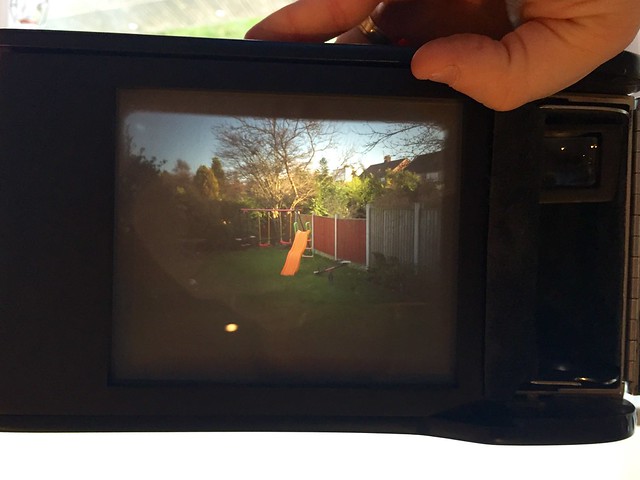The ground glass in my Shen Hao has been bugging me for a while. It's fine for focussing, but the image becomes markedly dull away from the centre and composition tends to be a bit hit or miss. I did some reading on Fresnel lenses, saw the prices, and decided to have a go at a DIY version. I went down to the local shops and picked up a cheapie Fresnel magnifier thing for a fiver, and set about fitting it to the camera.
First, get the camera back off and remove the ground glass...

I had been thinking of ways to fit this such that it didn't push the GG backwards, causing a focus shift. I was musing on a possible latch/catch setup at the corners, when I noticed the detail of the corners of the little ledge that the glass sits on...

The GG is only supported along the short edges. The two long edges are recessed by about 1.5mm. Having recently been looking at the Shen Hao web site, and noticing that they do an add-on Fresnel, I put 2 and 2 together and realised that these lower edges are for supporting that. The chaepie Fresnel is thicker at about 2.3mm, but I knew I could add rebates, so I got on with marking out for cutting...

The try square is set just off centre to allow for the width of the line of the fine marker pen. Four centre lines are marked at the edges. I took measurements of the space the Fresnel needed to occupy and then placed additional lines to indicate this size (half of each dimension from the centres)...

...and joined up the cut lines...

First, get the camera back off and remove the ground glass...

I had been thinking of ways to fit this such that it didn't push the GG backwards, causing a focus shift. I was musing on a possible latch/catch setup at the corners, when I noticed the detail of the corners of the little ledge that the glass sits on...

The GG is only supported along the short edges. The two long edges are recessed by about 1.5mm. Having recently been looking at the Shen Hao web site, and noticing that they do an add-on Fresnel, I put 2 and 2 together and realised that these lower edges are for supporting that. The chaepie Fresnel is thicker at about 2.3mm, but I knew I could add rebates, so I got on with marking out for cutting...

The try square is set just off centre to allow for the width of the line of the fine marker pen. Four centre lines are marked at the edges. I took measurements of the space the Fresnel needed to occupy and then placed additional lines to indicate this size (half of each dimension from the centres)...

...and joined up the cut lines...

Last edited:












 Added a fresnel screen to the rear of the ground glass and the difference in brightness is like night and day!
Added a fresnel screen to the rear of the ground glass and the difference in brightness is like night and day! Added a fresnel screen to the rear of the ground glass and the difference in brightness is like night and day!
Added a fresnel screen to the rear of the ground glass and the difference in brightness is like night and day!